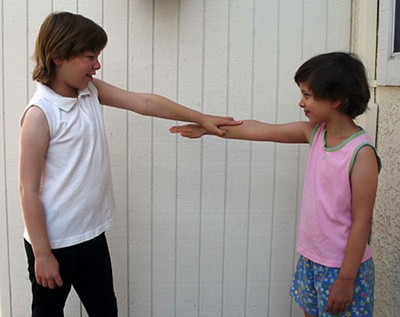Abstract
Have you ever watched a great sports player and imitated his or her moves over and over again? Or have you ever felt really bad when someone got hurt or things just weren't going his or her way? If so, you might be surprised to learn that you have been practicing skills closely tied to lying! In this science fair project, you'll discover how your brain gets a workout when it moves from truth-telling to lying, and how you can detect the shift. That's no lie!Summary
Kristin Strong, Science Buddies
This project was inspired by the experiments of Debora Capper and her son, Conrad.

Objective
To detect changes in the brain when a person is telling the truth and when a person is lying.
Introduction
Although lying is discouraged in many cultures, lying is a fundamental social skill that most humans begin to develop around age three. The development of lying is directly tied to the Theory of Mind. When you begin to understand that what you know about the world might be different than what another person knows, then you begin to have the capacity to lie. Lying is tied to empathy, which is the ability to "walk in another person's shoes," the ability to see things from another person's perspective.
People with certain brain-development problems, such as autism spectrum disorders, have great difficulty lying, and some people with autism never lie. Some neuroscientists (scientists who study the nervous system) believe that a problem with special brain nerve cells, called mirror neurons may be partly at fault. Mirror neurons are active whenever a person observes or tries to imitate another person's actions. Imitation is an important step toward empathy and viewing the world from another person's perspective. People with autism have difficulty with this skill.
Neuroscientists are also involved in helping the military, law enforcement, and security personnel detect lying in people suspected of having committed a crime. Standard lie-detection techniques include the use of a polygraph, a machine that measures the body's response to the stress caused by telling a lie. The polygraph continuously monitors heart rate, blood pressure, and sweating and watches for any increases in these that could signal that the person has just lied.
The problem with polygraphs, though, is that there can be false positives, which are false increases in heart rate, blood pressure, and/or sweating because of anxiety about the test or other unrelated issues. There can also be false negatives, where the person being investigated is telling a lie, but he or she either does not feel guilt about it, or has learned how to stop the body's responses to lies. This has led to an interest in developing alternative methods of detecting lies. The most promising machine is currently the functional magnetic resonance imaging, or fMRI scanner.
The fMRI differs from a standard MRI in that the standard MRI shows the brain's anatomy at high resolution (in great detail), whereas the fMRI shows how the brain is functioning and interacting, in lesser resolution, as the brain performs a specific task. fMRI maps blood flow to different regions of the brain in real-time. So, for example, if you were shown a photograph of a family member, the fMRI would tell the neuroscientists which parts of your brain were active when you looked at the image of your family member, such as the vision center, the emotional center, and the facial recognition center. With a standard MRI, your brain will look the same anatomically, regardless of what task you are doing—listening to music, looking a photograph, or telling a lie.
With fMRI, neuroscientists have discovered that your brain works harder when it is telling a lie, than when it is telling a truth! More and different parts of the brain are active during lying, as compared to truth-telling. While just four parts are active during truth-telling, seven parts are active during lying. In this science fair project, you'll take advantage of this difference in brain states to form a simple lie detector test. You'll give a person a physical task to do and have him or her tell a truth, and then tell a lie. You'll see if the person is better able to do the task when his or her brain is less active (telling a truth), or more active (telling a lie). So go call all your friends and family, and see if you can detect a harder-working brain!
Terms and Concepts
- Social skill
- Theory of Mind
- Empathy
- Autism spectrum disorder
- Neuroscientist
- Mirror neuron
- Polygraph
- Stress
- False positive
- False negative
- Functional magnetic resonance imaging (fMRI)
- MRI
- Real-time
- Brain state
- Resistance
Questions
- What does Theory of Mind mean?
- What does a polygraph do? Are they always accurate? Why or why not?
- What is the difference between fMRI and MRI? Why is low resolution better for detecting lies?
- How do the brains of people who are lying and those who are telling the truth differ when they are observed with fMRI?
Bibliography
This source provides some background information:
- Thebrainbank. (2013, March 15). Your Brain on Lies, Damned Lies and "Truth Serums". Retrieved March 2, 2016.
This source describes the parts of the brain that are active in truth-telling vs. lying:
- Society for Neuroscience. (2013, March 20). The Truth About Lies: The Science of Deception. Retrieved March 2, 2016.
This source describes functional magnetic resonance imaging, or fMRI machines:
- Wikipedia Contributors. (2008, July 7). Functional magnetic resonance imaging. Wikipedia: The Free Encyclopedia. Retrieved July 8, 2008.
This source describe how polygraphs work:
- Bonsor, K. (2008). How Lie Detectors Work. How Stuff Works, Inc. Retrieved July 8, 2008.
Materials and Equipment
- Volunteers (at least 10 and older than age 7)
- Lab notebook
- Paper
- Stool or stair (if needed)
Experimental Procedure
Testing Your Volunteers
- Have the first volunteer write down or tell you three things that he or she loves to eat or do, and two things that he or she dislikes to eat or do. For example, your friend might tell you that he loves skateboarding, swimming, and ice cream, and dislikes pepper and cleaning his room.
- Have the volunteer stand facing you, a few feet away. If you are much shorter than your volunteer is, then raise yourself up on a stool or stair so that it is easier for you to conduct the experiment.
- Have the volunteer extend his or her arm straight out in front, palm facing down. Tell the volunteer that you are going to have him say a few phrases and that you would like him to try to keep his arm up.
-
Extend your arm and place your hand, palm down, over the volunteer's hand and wrist, as shown in Figure 1.
 Image Credit: Kristin Strong, Science Buddies / Science Buddies
Image Credit: Kristin Strong, Science Buddies / Science Buddies
Figure 1. This photograph shows how to conduct a simple lie-detector test
- Tell the volunteer to say, I love to ________ (fill in the blank with the first word the volunteer wrote down in the list of things that he or she loves to do). This will be a truth. As the volunteer says the phrase, press down on the volunteer's arm. Apply steady, constant pressure. It is not necessary to force it all the way down if you cannot. You are just trying to get a sense of the resistance, or how hard it is to push down.
- Have the volunteer extend his or her arm again. Tell the volunteer to say, I love to vomit. This phrase will be a lie since nausea is universally an unpleasant experience. As the volunteer says the phrase, press down again on the volunteer's arm. Apply steady, constant pressure. Compare the resistance when the person was telling a truth with the resistance when the person was telling a lie. Write down which resistance felt greater to you, or if there was no difference, in a data table like the one below, in your lab notebook.
- Repeat steps 5-6 for the volunteer's second like and the volunteer's second dislike.
-
Repeat steps 5-6 for the volunteer's third like and the volunteer's third dislike.
Volunteer 1's Likes and Dislikes Data Table Likes Dislikes Swimming Vomiting Skateboarding Pepper Ice Cream Cleaning Room
Volunteer 1's Truths and Lies Data Table First Phrase of Likes (Truths) Second Phrase of Dislikes (Lies) Observed Arm Resistance: Greater for first phrase (the truth)? Greater for second phrase (the lie)? Or no difference? I love to swim. I love to vomit. I love to skateboard. I love pepper. I love ice cream. I love to clean my room. - Repeat steps 1-8 for at least nine more volunteers.
Combining and Analyzing Your Data Tables
-
Look at the observed arm resistances for each volunteer in the Truths and Lies Data Tables. Write down the one that occurred most frequently in the Combined Data Table. If none occurred most frequently, then write down, "No Difference."
Combined Data Chart Volunteer Name or Number Most Frequently Observed Arm Resistance:
Greater for the truth, the lie, or no difference?1. 2. 3. 4. 5. 6. 7. 8. 9. 10.
- Look at your Combined Data Table. Overall, was there greater arm resistance (meaning a better ability to complete the task of keeping the arm up), for the truths, the lies, or did you see no difference? If you saw a difference between truths and lies, what do you think accounts for this difference?
Ask an Expert
Global Connections
The United Nations Sustainable Development Goals (UNSDGs) are a blueprint to achieve a better and more sustainable future for all.
Variations
- Is it possible to defeat the lie detector test? Double the number of volunteers and randomly tell half of them prior to testing what you expect to see in the response of their arm when they lie, and when they tell the truth. Keep track of those volunteers that you told, and those that you did not. Did you see a difference between the two groups? Do you think it is important that the volunteers in a study know what the expected outcomes are? Or does that skew the results? What about the tester? Would it be better for the person doing the testing to be "blind" to the expected outcomes as well?
- Develop a different type of lie detector test using facial and/or body cues.
Careers
If you like this project, you might enjoy exploring these related careers:









